
Venice suffers from a major environmental issue. The land is boggy and the city is slowly sinking. The buildings don’t have proper foundations and are gradually subsiding into the waters of the lagoon. Its historic buildings are crisscrossed by hundreds of canals. Venice (or Venezia in Italian) is built on more than 100 small islands. The canals and surrounding lagoon are tidal and salty, and form part of a natural marsh flood plain.
The city grew because of its strategic location as a trading point between East and West. The architecture reflects the affluence and diverse origins of its settlers who accumulated huge wealth through trading in precious metals, gemstones, glass and silk. The impact of tourism and climate-change on the city are clearly visible. Walking routes around the city can change depending on the extent of the flooding. If you visit, take an up-to-date guide book with you
Venice, Italy is literally sinking. It has always experienced flooding from acqua alta (exceptionally high tides) but the frequency of these events has increased. There is a flood warning system with siren alerts, and text warnings that keeps residents informed of the likely severity of the floods. People prepare with wellington boots and raised walkways, but buildings are not so lucky.
The water levels are now permanently above the original damp proof courses of older homes and buildings in the city. Saltwater attacks the friable clay bricks causing them to crumble and let in more water. As a result, the ground floor of many of Venice’s buildings are now uninhabitable. To preserve them and prevent more erosion, underwater barriers have been installed to reduce the quantity of water entering the lagoon. The system became fully operational in the summer of 2021, more than 18 years after its construction began.
Picture Credit : Google




